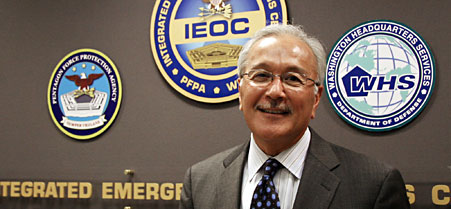Pentagon looks at TSA scanning technology to bolster security
The proposed security measure is among a host of ideas the Pentagon plans to roll out to boost building security after a gunman opened fire in March at the entrance to its headquarters and last year's Fort Hood, Texas, massacre.
 Steven Calvery says the Pentagon isn't "trying to reinvent the wheel" when developing a security system.
Steven Calvery says the Pentagon isn't "trying to reinvent the wheel" when developing a security system.
The Pentagon is considering installing scanning devices the Transportation Security Administration uses at airports to electronically screen Defense Department employees and visitors entering its headquarters.
This proposed security measure is among a host of ideas the Pentagon plans to roll out to boost building security after a gunman opened fire in March at the entrance to its headquarters and last year's Fort Hood, Texas, massacre .
"We spend a lot of time talking to the TSA about how they screen passengers," said Steven Calvery, director of the Pentagon Force Protection Agency, which safeguards the infrastructure, personnel and visitors at the Pentagon. The agency received $200 million in 2009 to implement a five-year program to make permanent the security measures put in place in the Pentagon after the Sept. 11 terrorist attacks.
Instead of "trying to reinvent the wheel," the division is evaluating TSA's best practices and screening devices to see if they can be applied to the Pentagon, Calvery said. "We think a lot of it will work here."
The security infrastructure protecting the Pentagon -- a bustling complex that 25,400 people enter on any given workday and that is surrounded by three major highways -- is mostly "old and antiquated," he said. Screening everyone entering and exiting the complex is a "physical impossibility," said Calvery, who added 3,000 to 4,000 people stream in each hour through the main entrance near the Pentagon Metro station during the morning rush hour. Approximately 23,000 employees work at the Pentagon.
Police officers stationed at entrances perform random screening checks on employees, selecting some to walk through metal detectors and to conduct bag checks. But full screening is not carried out on a daily basis. "It helps to mitigate the threat, but doesn't eliminate the threat," said Calvery, who added security personnel have intercepted employees bringing in knives, Mace and in one instance following the latest shooting, a loaded handgun.
The agency also is considering putting into place a departmentwide identification card system containing biometric markers. This measure was driven by Homeland Security Presidential Directive 12, which mandates secure and reliable forms of identification for federal employees and contractors.
Pentagon employees usually show their ID passes to a security officer, walk through the doors of the building, and are granted entry. "In the future, you'll walk up to a full-height turnstile, you'll swipe your card, and either you'll have to enter a PIN, or we'll scan your iris," predicted Calvery, who said his agency is evaluating a variety of possible biometrics to ensure the best fit.
Because most chemical and biological detection technologies detect toxic agents only after they have entered the building, the division is installing sensors to detect agents released outside the building. The new protection program is partially in place and will be synchronized with the renovation of the Pentagon, which is expected to be completed in 2011.
"The incident on March 4 was kind of a wake-up call for us," said Calvery, adding the inside threat is one that every federal facility faces.
NEXT STORY: A Hooah for the Guard


